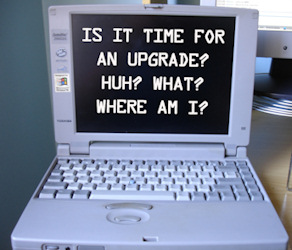The computers I used for digital modes
 The configurations described below date from before 2001 (!), so in the meanwhile a lot of (much) more sophisticated computers have been assembled. But for the digital modes that you find on my webpages, old configurations are still perfectly usable, which is illustrated by the descriptions you will find below.
The configurations described below date from before 2001 (!), so in the meanwhile a lot of (much) more sophisticated computers have been assembled. But for the digital modes that you find on my webpages, old configurations are still perfectly usable, which is illustrated by the descriptions you will find below.
In the beginning of my hamradio days, I used a C64 with a home-made packet modem, running Digicom software. It was later on replaced by a Commodore 128. Nowadays I have a network of home-assembled PCs to run all sorts of ham software. Well-known story, no ?
The first steps in digital modes were made with the purchase of baycom modem, designed for packet radio at 1200 baud. Soon after, a PAK-93-MM multimode modem was bought, which can be used to get access to the different digital modes available. This includes RTTY, SSTV, FAX, ... on shortwave frequencies as well as packet radio on UHF (70 cm). After my first trials (and errors, hi), I explored the possibilities of using a sound card as interface for digital modes. After buying a second hand TNC2C and a brand new TNC2X, and regarding the fact that I owned several transceivers, I got tired of connecting and disconnecting all cables when switching configurations and moreover, I could not work more then 1 digital application at a time. So I started to use separate computers for different modes.
At first, the baycom or the PAK-93-MM modem was connected to a very small and old Toshiba laptop T1900S which I saved from the waste container (really !!). Thanks to the limited system requirements of the used software (HamComm, JVFAX, Graphic Packet, ...) this laptop has enough capabilities to run most of the digital modes : a processor 486SX-25 MHz with 4 MB EDO RAM, a hard disk of 130 MB and a 3 1/2" diskette station.
Since it has no colour screen, a 13" IBM monitor was attached to it, improving the readability of the incoming signals.
One day, browsing on the internet, I came to an auction site where I found the successor of this laptop, the Toshiba T1910CS, having a faster processor, a larger hard-disk and a color screen. This laptop soon replaced the foregoing. It can be briefly described as follows :
Toshiba Laptop T1910CS - 486 - 200 MB hard disk - 4 MB RAM - DOS 6.22 and Windows 95 in dual-boot installed with PowerQuest software.Thanks to the ability of running Windows 95, I used it even to maintain my logbook with the program DX4WIN.
Then, for more complex ham software, as there is the calculation of orbiting satellites, PCB (Printed Circuit Board) design, digital ham modes, or other usefull software running under Windows95, the following, so-called 'ham PC' configuration was used :
Intel Pentium III 500 MHz MMX - 512 MB EDO RAM 72 pins (60ns) - 15" ViewSonic monitor E655 - video card Diamond Stealth S220 with 4 MB SGRam - internal Iomega 100 Mb ZIP drive - hard disk Quantum Fireball CX 6.1 GB - 3 1/2" diskette station - CD ROM 50 speed - 128 bit Creative SoundBlaster PCI - Ethernet IEEE 802 network-card with capability of full-duplex at 20 Mbps effective bandwidth - Windows 98 installed.